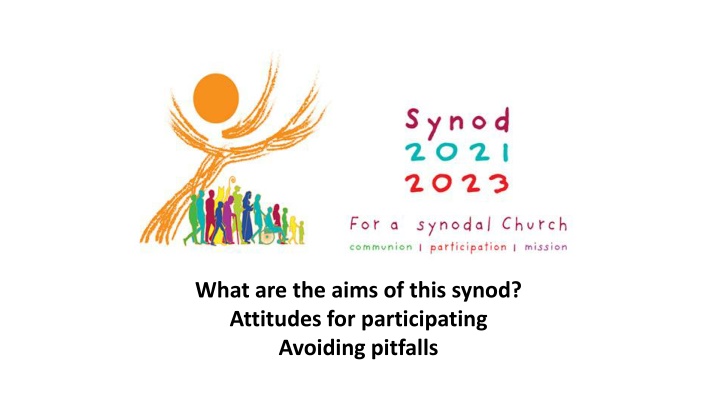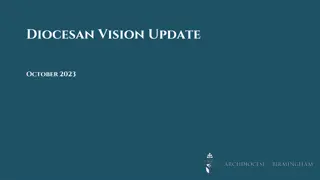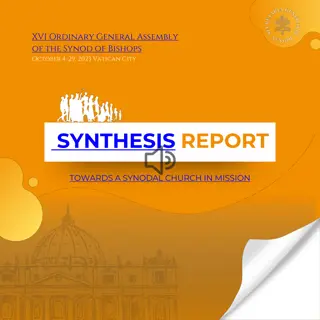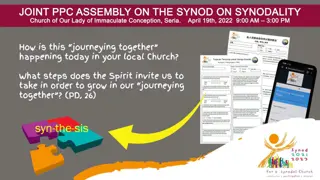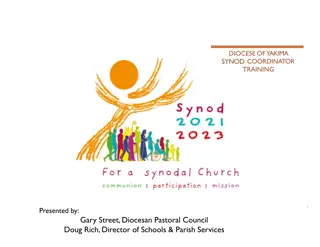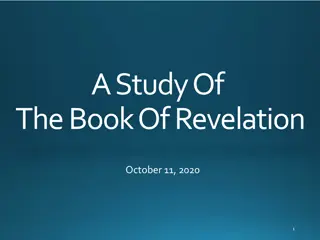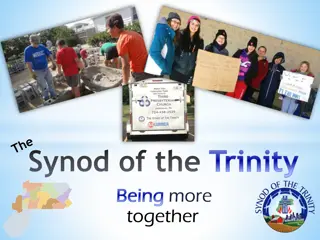Aims of Synod: Journeying Together as People of God
The synod aims to empower the entire People of God towards a more synodal Church, fostering discernment, participation, and co-responsibility. Through listening to each other and the Holy Spirit, it seeks to inspire hope, trust, and unity, while challenging existing mentalities and structures for a renewed Church mission.
Download Presentation

Please find below an Image/Link to download the presentation.
The content on the website is provided AS IS for your information and personal use only. It may not be sold, licensed, or shared on other websites without obtaining consent from the author.If you encounter any issues during the download, it is possible that the publisher has removed the file from their server.
You are allowed to download the files provided on this website for personal or commercial use, subject to the condition that they are used lawfully. All files are the property of their respective owners.
The content on the website is provided AS IS for your information and personal use only. It may not be sold, licensed, or shared on other websites without obtaining consent from the author.
E N D
Presentation Transcript
What are the aims of this synod? Attitudes for participating Avoiding pitfalls
What are the aims of this synod? The mission of the Church requires the entire People of God to be on a journey together, with each member playing his or her crucial role, united with each other. to provide an opportunity for the entire People of God to discern together how to move forward on the path towards being a more synodal Church in the long-term. (Vademecum for the Synod on synodality, 1.3)
What are the aims of this synod? The Second Vatican Council reinvigorated the sense that all the baptised, both the hierarchy and the laity, are called to be active participants in the saving mission of the Church (LG, 32-33). The path of synodality seeks to make pastoral decisions that reflect the will of God as closely as possible, grounding them in the living voice of the People of God (ICT, Syn., 68). (Vademecum for the Synod on synodality, 1.3)
What are the aims of this synod? The fundamental question How does this journeyingtogether take place today on different levels (from the local level to the universal one), allowing the Church to proclaim the Gospel? and what steps is the Spirit inviting us to take in order to grow as a synodal Church? (Vademecum for the Synod on synodality, 1.3)
What are the aims of this synod? In this light, the objective of the current Synod is to listen, as the entire People of God, to what the Holy Spirit is saying to the Church. We do so by listening together to the Word of God in Scripture and the living Tradition of the Church, and then by listening to one another, and especially to those at the margins, discerning the signs of the times. the whole Synodal Process aims at fostering a lived experience of discernment, participation, and co-responsibility, where a diversity of gifts is brought together for the Church s mission in the world. (Vademecum for the Synod on synodality, 1.3)
What are the aims of this synod? it is intended to inspire people to dream about the Church we are called to be, to make people s hopes flourish, to stimulate trust, to bind up wounds, to weave new and deeper relationships, to learn from one another, to build bridges, to enlighten minds, warm hearts, and restore strength to our hands for our common mission (PD, 32) . This journey together will call on us to renew our mentalities and our ecclesial structures in order to live out God s call for the Church amid the present signs of the times. (Vademecum for the Synod on synodality, 1.3)
Attitudes for participating Making time for sharing Humility in listening an courage in speaking Dialogue leading us to newness Openness to conversion and change Willingness to undertake a common exercise of discernment Opening of ourselves to authentic listening (From Vademecum for the Synod on synodality, 2.3)
Attitudes for participating Leaving behind prejudices and stereotypes Avoiding clericalism Trying to build bridges instead of retreating to self-sufficient Overcoming ideologies Openness to hope Dreaming of a joyful future (From Vademecum for the Synod on synodality, 2.3)
Attitudes for participating A fruitful and creative dialogue will require of participants: to develop an innovative outlook to be inclusive to have an open mind to listen to each and all to journey together to be an active part of a co-responsible Church to reach out through ecumenical and interreligious dialogue (From Vademecum for the Synod on synodality, 2.3)
Avoiding pitfalls Progress on our journey could be hampered by the following temptations: 1. Falling into the trap of corporativism, instead of opening ourselves to the actions of the Holy Spirit 2. Focusing on the immediate rather than reaching out to the peripheries and thinking long-term 3. Seeing only problems and missing the light (Vademecum for the Synod on synodality, 2.4)
Avoiding pitfalls 4. Focusing only on structures and obstructing the individual and collective renewal of the whole Body of Christ 5. Looking inwardly instead of forging a dialogue with those involved in the social, political, economic and cultural spheres, as well as with Christians of different denominations and believers of different faith traditions (Vademecum for the Synod on synodality, 2.4)
Avoiding pitfalls 6. Losing focus on synodality and discernment 7. Sowing the seeds of conflict and division 8. Treating the synod as a political battle 9. Listening only to those who play an active part in the Church and forgetting about those on the periphery (Vademecum for the Synod on synodality, 2.4)
In order for this to happen, it is necessary to make significant efforts to involve the highest number of people possible in a meaningful way. ( ) Superficial or scripted input that does not accurately and richly represent the experience of the people will not be helpful, nor that which does not express the full range and diversity of experiences. (Vademecum for the Synod on synodality, 4.1)
